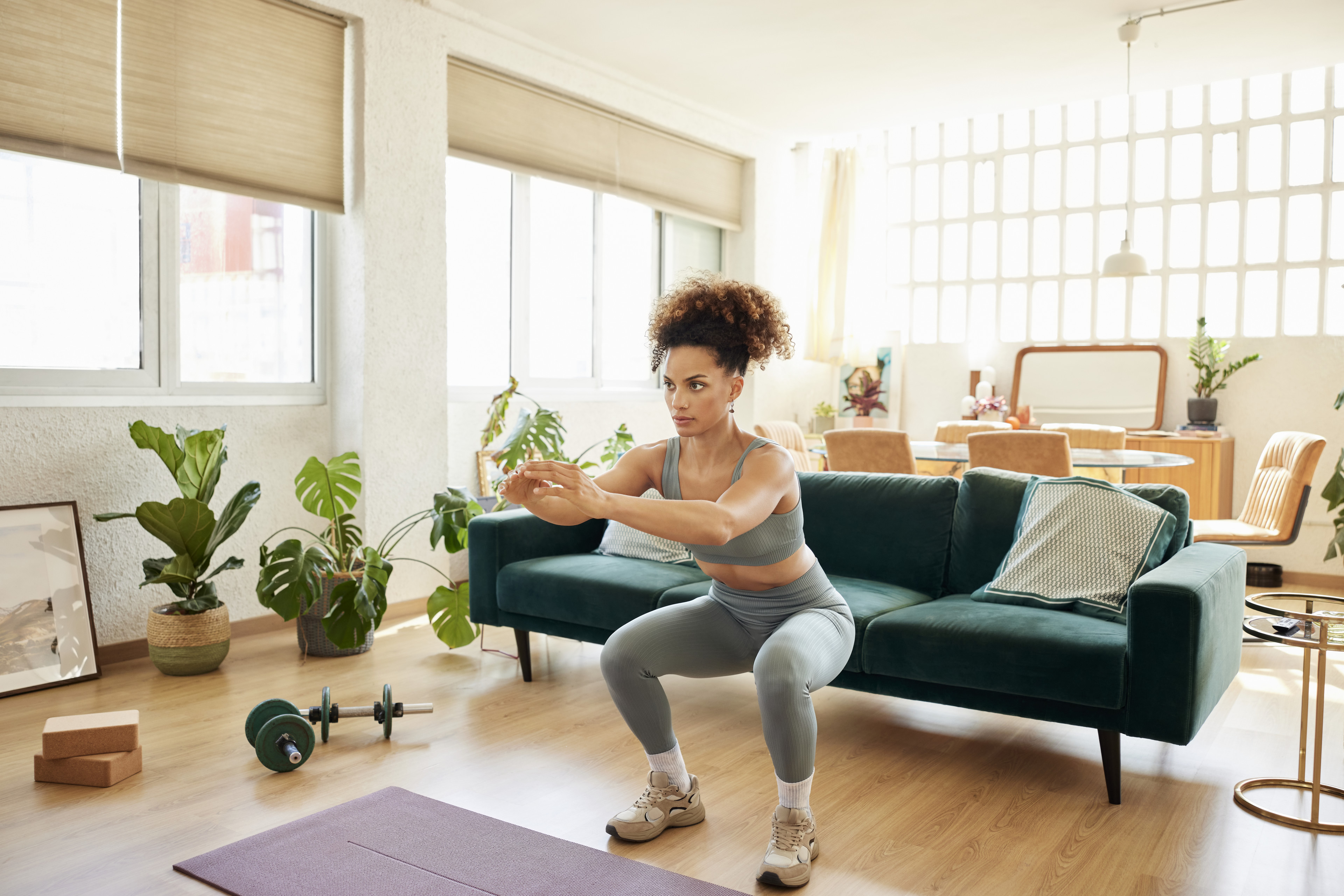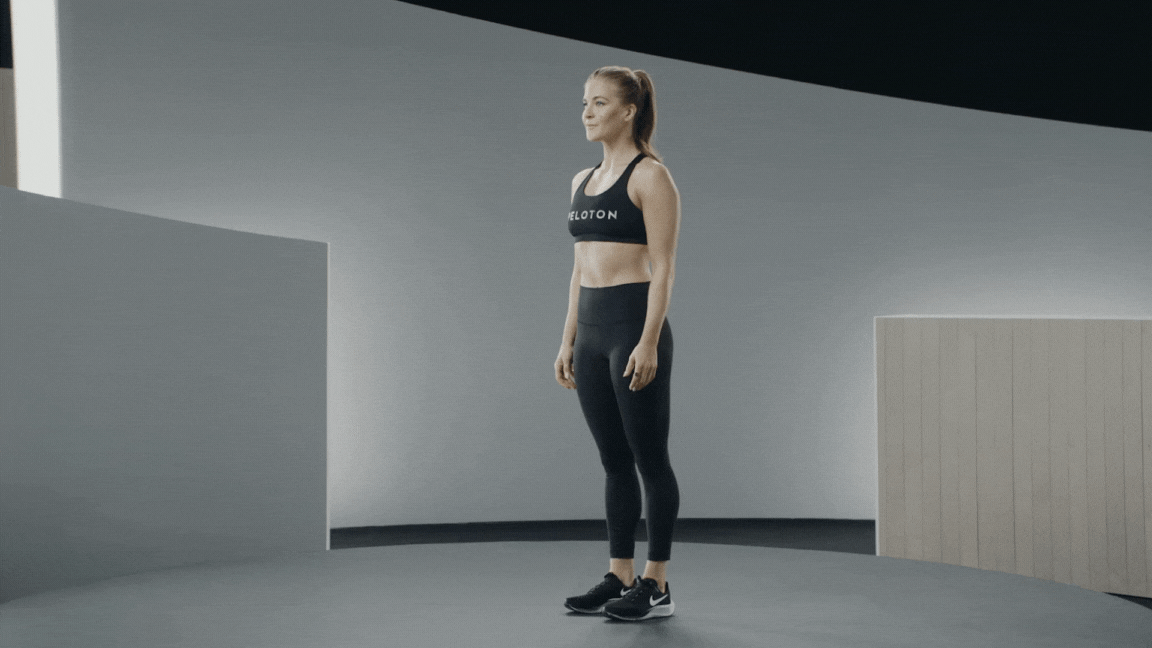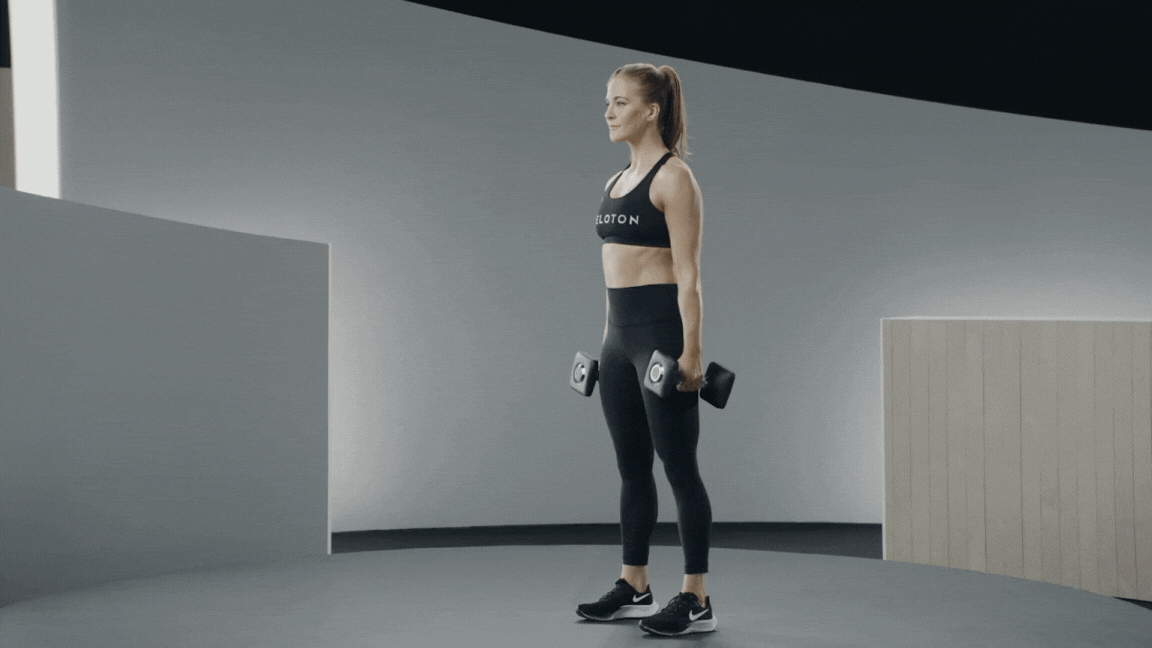
Morsa Images/DigitalVision via Getty Images
How to Do a Squat with Perfect Form
Learn proper squat technique and why it's a fundamental move for everyone, from beginners to elite athletes.
By Colleen Travers, Team Peloton•
What Are the Benefits of Doing Squats?
How to Do a Squat with Proper Form
Which Muscles Do Squats Work?
Common Squatting Mistakes and How to Fix Them
How to Add Weight to Squats
How Often Should You Do Squats?
In our humble opinion, lots of great things are “basic.” When it comes to strength training, for example, the squat is one of the most basic moves you can do. Yet, it comes with serious benefits: Including squats in your strength training routine can pay off big when it comes to building muscle, getting stronger, and exercising for longevity.
Discover more ways to reach your goals with Peloton
For more proof that simple squats deserve the hype, read on to learn why they’re a must-do move (for athletes and those who just want to move well through life), how to do a squat correctly, and some common mistakes to avoid when it comes to your form.
What Are the Benefits of Doing Squats?
“Squats are a great exercise because they engage multiple parts of the body and, at the most basic level, require no equipment or machinery,” says Peloton instructor Tunde Oyeneyin. Below are some of the perks of perfecting your squat and making it a mainstay in your routine.
Increased Muscle Mass and Strength
Squats are a compound exercise, meaning they’re a multi-joint movement that engages multiple muscle groups. Specifically, they engage some of the largest muscles in the body, including your quads (on the front of your thighs), hamstrings (on the backs of your thighs), and glutes. “While squats primarily strengthen and target the muscles in the legs, glutes, and core, they also contribute to overall health by improving bone density and enhancing the ability to perform everyday movements (i.e., sitting and lifting),” Tunde says. “This, in turn, increases your overall strength while helping prevent injury or strain.”
Improved Athletic Performance
Whether you run, ride, swim, compete with others, or want to push yourself and PR, all strength training is important when it comes to athletic performance. According to a 2014 research review published in Sports Medicine, strength training improves neuromuscular efficiency, which is your nervous system’s ability to recruit and coordinate your muscles to produce movement. By improving your neuromuscular efficiency, you can move more efficiently, using less energy and more force.

Peloton App
Access thousands of classes with no equipment needed.
Reduced Risk of Injury
You squat a lot in life without realizing it. Sitting, lifting groceries or a kid, and even some sports and activities require a squat. That’s why focusing on your squat form won’t just make you stronger, but will also help protect you from injury. Research published in the Strength and Conditioning Journal found that mastering the squat movement pattern preps the body for the demands it encounters during physical activity and daily living, and helps protect the back and lower body from injury during functional movements and training.
Boosted Bone Density
Bone density is a measurement of the amount of minerals present in a specific area of bone, and it acts as an important indicator of how likely they are to break, according the National Council on Aging. As you age, especially for those 50 years and older, your body loses bone mass faster than it can rebuild it. This can lead to osteoporosis, a condition that affects 43.3 million adults in the US, according to the Centers for Disease Control and Prevention (CDC).
But exercise (and strength training, in particular) can help you maintain and increase bone density. One 2013 study published in the Journal of Strength and Conditioning Research found that incorporating squats into a strength training routine improved the skeletal health of postmenopausal women with osteoporosis. Another study found that resistance training with squats improved bone mineral density in young adult women.
Better Balance and Coordination
According to research published in 2019 in the Journal of Athletic Training, there’s a direct link between core control, balance, and a reduced risk of injury. When done with proper form, a squat requires you to engage your core as you complete the full movement. Learning to activate and stabilize your core while moving, such as during a squat, can help to improve your balance and allow you to move more safely and efficiently, whether you’re dashing down a soccer field or stepping over a puddle.

How to Do a Squat with Proper Form
“When it comes to squats, form is everything,” Tunde says. “I recommend starting with basic bodyweight squats until you’ve perfected your technique without using any added weight.” To do a squat correctly, follow these steps.
1. Find Your Stance
Stand with your feet shoulder-width distance apart or slightly wider, and your toes turned out just a bit, as if pointing to 11 and 1 on a clock, Tunde says. Make sure your weight is evenly distributed between both feet, and that you’re grounding down through all corners of your feet.
Clasp your hands in front of your chest and hold them there, or move them in and out of this position (as shown above).
2. Bend at the Hips and Knees
Engage your core. Inhale and simultaneously bend your knees and sit your hips back, lowering your body as if you were about to sit in a chair. “With your chest remaining upright, slowly lower while actively firing tension through the entire lower body,” Tunde says. Keep your knees tracking forward over your feet. Allow your torso to hinge forward slightly, but keep your chest proud (not rounded forward).
3. Pause at the Bottom
Pause when your thighs are about parallel to the floor, or just below. If you can’t go that low, go to whatever depth is accessible and comfortable for you. Your core should remain engaged and back flat even at the bottom of your squat. Keep your neck long and in a neutral position, with your gaze forward.
4. Drive Into Your Feet to Stand
Exhale and press evenly into both feet to straighten your knees, push your hips forward, and stand.
Which Muscles Do Squats Work?
“Squats primarily work the quads, hamstrings, and calves,” Tunde says. “They also work your glutes and core muscles, which include your lower back and abdominals.” Here’s a breakdown of the main muscles worked in a squat:
Quadriceps: These muscles on the front of your thigh work to straighten your knee, and jump into action to help you stand up from a squatting position.
Hamstrings: During a squat, the hamstrings, which run up and down the back of your thigh, help stabilize your knee and control your motion as you bend your knees and sit your hips back. Along with the glutes, the hamstrings also help straighten your hips when you press up to standing.
Calves: The calf muscles on the back of your lower leg work to stabilize your ankle, foot, and knee and help you push out of the lowest position of your squat.
Glutes: Your glutes work to stabilize and extend (straighten) your hips, pushing you up and out of the bottom of the squat and helping you return to standing.
Core: During squats, your entire core works hard to stabilize your torso while you move. This includes your deep core muscles, such as the transverse abdominis, as well as your lower back.
Squat variations can help you hit even more muscle groups. As you progress from a basic squat, trying different types of squats, such as a sumo squat (a squat with a wider stance, feet slightly angled out to the sides) or jump squat, will target areas like your hip flexors and adductors (the muscles that go from the pelvic bone to the inner thigh). Plus, adding weight with additional variations like the overhead squat (squatting while holding a weight overhead) will increase the challenge on your upper body, hitting the back and shoulder muscles too.
Common Squatting Mistakes and How to Fix Them
It’s important to perform squats with proper form to avoid injury. “Because there’s so much to focus on, I recommend starting simple until you feel comfortable with the motion,” Tunde says. “Then you can add equipment and/or machines.”
Here are some common squatting mistakes, according to Tunde, and what you can do to fix them. If needed, consult a fitness professional or physical therapist to get individualized form feedback and make sure you’re performing squats correctly.
Starting with an incorrect stance. If your feet are too narrow, wide, or positioned at the wrong angle, you won’t be able to squat with proper form. Play with your foot placement to find the most comfortable setup for you; the ideal squat position will be slightly different for everyone depending on their anatomy, according to the American Council on Exercise (ACE).
Leaning too far forward. This is a common mistake, Tunde says. Too much of a forward lean puts increased pressure on your lower back, according to the National Academy of Sports Medicine (NASM). Your torso should angle forward slightly, but you should aim to keep a flat back.
Forgetting about your core. It’s important to engage your core throughout the movement, Tunde says. This helps prevent excessive arching of the lower back. To do so, imagine bracing your stomach as if someone were about to punch you or if you were about to sneeze, and try to maintain that engagement throughout your squat reps.
Allowing your knees to collapse in. Improper knee alignment is another common mistake, according to Tunde. Make sure your knees are tracking over your feet, with your toes pointed slightly out to help push those knees out instead of in.

How to Add Weight to Squats
It’s best to first master bodyweight squats before tacking on additional resistance via weights or machines, Tunde says. “Once you feel comfortable, you can begin incorporating weight, machines, and different variations of the squat, such as sumo squats, goblet squats, or jump squats,” she says.
When you’re ready to add weight, start with a light weight (5–10 pounds), and then work your way up as you get stronger. You’ll know you’re ready to pick up a heavier weight when you’re no longer feeling tested; a sign you’ve chosen the right weight is that you can finish each set with good form, but the last couple of reps challenge you.
How should you hold the weight? And which weights should you use? You have a lot of options, including goblet squats (which involve holding a single dumbbell or kettlebell in front of your chest), dumbbell squats (which are typically done by holding a dumbbell over each shoulder or by your sides, as shown above), and barbell squats (which are an advanced move you can use to lift even heavier weights).
How Often Should You Do Squats?
Frequency is key to seeing the benefits of any exercise, including squats.
“I recommend starting with bodyweight squats—about 3 sets of 10–15 reps, two to three times per week—whether that’s on leg day or as part of a full body workout,” Tunde says. Incorporating squats into your strength training routine several times per week will give your muscles enough time to recover between workouts, but allow you to train the muscle groups often enough to build muscle and strength.
As you get stronger, increase the frequency and difficulty of your strength training workouts by adding more weight and or sets to continue seeing progress and avoid a plateau. And remember, squats and other strength training exercises may be difficult, but should never cause pain. Listen to your body and take rest days when needed. If you do feel pain, stop the exercise and consult a physical therapist or doctor.
Related Articles
This content is for informational and educational purposes only and does not constitute individualized advice. It is not intended to replace professional medical evaluation, diagnosis, or treatment. Seek the advice of your physician for questions you may have regarding your health or a medical condition. If you are having a medical emergency, call your physician or 911 immediately.
Level up your inbox.
Subscribe for a weekly dose of fitness, plus the latest promos, launches, and events.
By providing your email address, you agree to receive marketing communications from Peloton.
For more about how we use your information, see our Privacy Policy.












